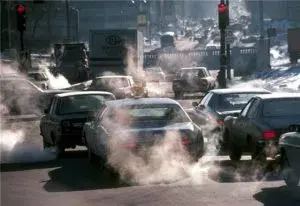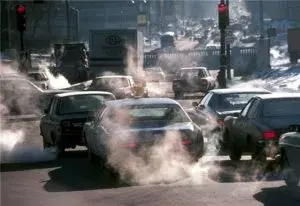Authorizations required under Central Pollution Control Board
 CPCB is entrusted with the task of prevention, control and abatement of pollution and waste. It works closely with the State Pollution Control Board (SPCB) and provides its technical assistance and guidance to state boards.
CPCB is entrusted with the task of prevention, control and abatement of pollution and waste. It works closely with the State Pollution Control Board (SPCB) and provides its technical assistance and guidance to state boards.
Liability of Vehicle Manufacturers-Deficiency in Service by Dealer/Authorized Service Centre
 The Court held that the manufacturer of a vehicle could not be held liable for any deficiency in service by the dealer or service centre while rendering assistance for repairs of the vehicle.
The Court held that the manufacturer of a vehicle could not be held liable for any deficiency in service by the dealer or service centre while rendering assistance for repairs of the vehicle.
Economic Survey on Cross Border Insolvency
 The current provisions under the Insolvency and Bankruptcy Code, 2016 are ad-hoc in nature and are susceptible to delay. Entering into mutual (reciprocal) agreements require individual long-drawn-out negotiations with each country which leads to uncertainty of outcomes of claims.
The current provisions under the Insolvency and Bankruptcy Code, 2016 are ad-hoc in nature and are susceptible to delay. Entering into mutual (reciprocal) agreements require individual long-drawn-out negotiations with each country which leads to uncertainty of outcomes of claims.
Builder’s Failure to provide Occupancy Certificate is Deficiency of Services- SC
 In a recent case, the Hon’ble Supreme Court held that a builder’s failure to provide the Occupancy Certificate to flat owners is deficiency of service under the Consumer Protection Act, 1986.
In a recent case, the Hon’ble Supreme Court held that a builder’s failure to provide the Occupancy Certificate to flat owners is deficiency of service under the Consumer Protection Act, 1986.
Authorizations required under Central Pollution Control Board

By Rupin Chopra and Apalka Bareja
In recent times, environmental concerns have been a hot topic not just in India but worldwide. Government and non-profit organizations are working hand in hand where Governments of various nations are implementing schemes and laws to safeguard the environment, non-profit organizations are creating awareness about the importance of sustainable environment.
One such initiative taken by the law enforcers of India to protect the environment was through the establishment of Central Pollution Control Board (CPCB). CPCB is entrusted with the task of prevention, control and abatement of pollution and waste. It works closely with the State Pollution Control Board (SPCB) and provides its technical assistance and guidance to state boards. It further collects and publishes statistical and technical data relating to pollution levels and provides measures and guidelines to combat it.
In order to keep a check on producers, manufacturers, importers of products causing pollution and generating waste, government mandates various authorizations to be granted by CPCB.
This piece discusses the various authorizations required from CPCB along with the necessary documents and eligibility criteria in that regard.
- Extended Producer Responsibility (EPR) Authorization for E-waste Management
EPR is the responsibility of every producer of electric or electronic equipment to channelize e-waste to ensure its sound management and disposal.
Eligibility
As per E-waste management Rules, 2016[1] CPCB has the mandate to grant, renew or refuse EPR-Authorization to Producers of the Electrical &Electronic Equipment (EEE) listed in schedule — I of the said Rules. Schedule-I lists down two categories of EEE- Information technology and telecommunication equipment and Consumer electrical and electronics.
Information required
A Producer has to apply, providing the following information as per Form-1 of E-waste management Rules, 2016. Application can be submitted by post or courier services.
General information
- Name, full address and contact details of the place where sale in entire country is being managed.
- Name of the authorized person along with his/her address and contact details
- Name, address and contact details of Producer Responsibility Organization (PRO), if engaged. PRO means a professional organization authorized or financed collectively or individually by producers for channelization of e-waste generated.
- Details of electrical and electronic equipment placed in market year-wise as per Table-1.
Estimation of E-waste Generation
Estimated generation of Electrical and Electronic Equipment waste item-wise and estimated collection target for the forthcoming year in the form of Table 2
Extended Producer Responsibility (EPR) Plan
- This plan shall outline the scheme of e-waste channelization system for targeted collection including details of PRO if any
This information is to be submitted in the following format;
- General scheme of collection
- Channelization of E-waste and it’s flow chart
- Website Information
- Plan shall include estimated budget for Extended Producer Responsibility and consumer awareness.
- Details of proposed awareness program.
Reduction of Hazardous Substances (RoHS)
A self-declaration on compliance to Reduction of Hazardous Substances to be submitted along with a declaration that technical documents on RoHS are available with them and will be provided for verification whenever required.
List of Documents Required
- EPR plan
- Copy of permission from the relevant Ministry/Department for selling their product
- Copies of agreement with dealers
- Copies of agreement with collection centers
- Copies of agreement with recyclers / dismantler
- Copies of agreement with treatment, storage and disposal facility (TSDF), if applicable
- Copy of license/permission from Directorate General of Foreign Trade (DGFT)
- Self-Declaration on RoHS
- Copy of agreement with PRO, if applicable
| S.No. | Checklist for evaluation of Application of EPR Authorization |
| 1. | Name and full address along with telephone numbers, e-mail and other contact details of Producer |
| 2. | Name of the Authorized Person and full address with e-mail, telephone and fax number |
| 3. | Name, address and contact details of Producer Responsibility Organization, if any |
| 4. | Details of electrical and electronic equipment (EEE) placed in market year-wise (As per Table-1). |
| 5. | Estimated generation of WEEE |
| 6. | EPR-Plan: General Scheme of Collection |
| 7. | EPR-Plan: Channelization of E- Waste and it’s flow-chart |
| 8. | ERR-Plan: Web-site information |
| 9. | Budget for collection & channelization, Schemes and awareness programmes |
| 10. | Details of proposed awareness programmes. |
| 11. | Details for ROHS compliance: Self-declaration on compliance to ROHS |
| 12. | Details for ROHS compliance: Declaration on possession of technical documents on RoHS |
| 13. | ERR plan |
| 14. | Copy of permission from the relevant Ministry/Department for selling their product |
| 15. | Copies of agreement with dealers |
| 16. | Copies of agreement with collection centers |
| 17. | Copies of agreement with recyclers/dismantler |
| 18. | Copies of agreement with TSDF, if applicable |
| 19. | Copy of DGFT license/ permission (IEC certificate) |
| 20. | Self-declaration on ROHS |
| 21. | Copy of agreement with PRO, if applicable |
Target Time and Response
CPCB shall issue EPR Authorization within 120 days from the date of receipt of complete applications. If the application is complete in all respect CPCB may take lesser time. The status of the application will be displayed in a simple web based application at CPCB website.
Approval, renew and amendment of EPR Authorization
- Chairman of CPCB shall approve the EPR Plan after the concerned official has scrutinized it. Upon approval, Divisional Head dealing would issue the EPR Authorizations.
- In case of renewal and amendment of existing EPR Authorization, Member Secretary of CPCB shall be the approving authority. Upon approval, Divisional Head would issue the renewed/amended EPR Authorizations.
Registration of Producers, Importers & Brand-Owners (PIBOs) for Plastic Waste Management
CPCB Is currently registering PIBOs in accordance with the provision of Plastic Waste Management (PWM) Rules 2016, as amended. In this regard CPCB has issued Standard Operating Procedure[2] and launched online portal.
On this matter, a draft notification[3] was issued by Ministry of Environment, Forest and Climate Change on October 6, 2021 which was to be implemented with immediate effect. However, it has been kept in abeyance for three months by a notification issued on October 20, 2021 by CPCB[4].
Eligibility
As per the provision of PWM Rules, Extended Producers Responsibility (EPR) for management of plastic waste packaging is entrusted with the PIBOs who introduce the products in the market.
For the purpose, “Brand owner” means a person or organization who sells any commodity under a registered brand label and “Producer” means persons engaged in manufacture or import of carry bags or multi-layered packaging or plastic sheets or like. Producers also include industries or individuals using plastic sheets or like or covers made of plastic sheets or multi-layered packaging for packaging or wrapping the commodity
Procedure for issuance of Certificate by Central Pollution Control Board
As per Rule 13(2) of the PWM Rules, PIBOs who are operating in more than two states, are required to obtain registration from Central Pollution Control Board and those operating in one or two states have to obtain registration from the concerned SPCB/PCC
- The PIBOs shall apply to CPCB for the registration online on the portal. The application format is in to be in accordance with Form-I of PWM Rules 2016. Application fee, as prescribed, shall be paid by PIBO at the time of submitting the application for Registration with CPCB.
- EPR Action Plan is to be submitted by PIBOs for obtaining registration from Central Pollution Control Board. PIBOs shall fulfill EPR in all the States/UTs in which they are introducing their products. EPR Target for a particular State/UT shall be equal to the type & quantum of plastic introduced by them in the market (post consumer waste) in the specific State /UT.
Checklist of documents to be submitted for Obtaining Registration from CPCB
(a) Proof of Selling in more than two states ( GST/ tax invoice etc)
(b) DIC Certificate, if the unit has a production facility
(c) Valid Consents under Air & Water Act, if the unit has a production facility
(d) Documents related to Action Plan for fulfilling EPR liability ( State/UT wise)
- Document issued by Urban Local Body / designated state authority related to engagement of PIBO or Waste Management Agency (WMA) (as applicable)
- Registration issued by SPCBs/PCCs to Plastic Waste Processing Facility (PWPF) to be engaged with for plastic waste (PW) processing
iii. Agreement of PIBO/WMA with PWPF for PW processing (as applicable)
- Agreement of PIBO with WMA (as applicable)
- Fresh Registration valid for a period of one year in accordance with PROVISION of PWM Rules shall be issued to the PIBOs. Registration certificate shall be issued online to PIBOs within seven working days of submission of complete application
Registration of the Importers of new Lead Acid Batteries
As per the provision under Rule 5 of Batteries (M&H) Rules, 2001 and as amended in May 2010, responsibility for granting registration to importers of the new lead acid batteries has been delegated by Ministry of Environment, Forest & Climate Change to Central Pollution Control Board w.e.f. 4th May, 2010.[5]
Procedure for Registration
- Applicant shall apply for the grant of registration through online web-portal www.cpcbbrms.nic.in
- After submission of online application, applicant shall also submit physical copy of application on their letter head, enclosing following documents;
- Printouts of Form II and Form III taken out from online application with their stamp and signature on the same.
- Self-attested copy of Import-Export certificate
Documents and Information required for registration[6]
- Name of the importer
- Name of the person/owner
- Industry address
- Import export code no.
- Contact details- mobile no., FAX no., e-mail id, pin code
- PAN cards
- Import Export Certificate
Undertaking in Form-III
[1] http://www.bareactslive.com/ACA/ACT2903.HTM
[2] https://cpcb.nic.in/uploads/plasticwaste/SOP_EPR_PWM_23-03-2021.pdf
[3] https://moef.gov.in/wp-content/uploads/2021/10/Draft-notification-EPR.pdf
[4] https://cpcb.nic.in/openpdffile.php?id=TGF0ZXN0RmlsZS8zMzdfMTYzNDgwMDUyNF9tZWRpYXBob3RvMjAzMTAucGRm
[5] https://cpcb.nic.in/displaypdf.php?id=aHdtZC9OZXdfU29QX0JhdHRlcmllc18yMDE2LnBkZg==
[6] https://cpcb.nic.in/uploads/hwmd/BRMS_Proc_20082018.pdf
Related Posts
Government Notification Regarding Measures to Curb Pollution
Renewal of Vehicle Insurance- Pollution Under Control (PUC) Certificate mandatory
Liability of Vehicle Manufacturers-Deficiency in Service by Dealer/Authorized Service Centre

By Manmeet Singh Marwah and Devika Mehra
Manufacturers, service providers, or sellers, as the case may be are liable to compensate consumers for defects in goods or deficiency in services. Vehicle manufacturers usually enter into agreements with dealers or service centres on a principle-to-principle basis, which implies that there are no intermediaries or agents involved in the transaction. This ensures that manufacturers are not liable for any deficiencies in service arising from the dealer’s/service centre’s dealings with consumers, and restricts their liability to harm caused due to manufacturing defects. In Honda Cars India Ltd v Sudesh Berry[7], the Supreme Court reiterated that vehicle manufacturers cannot be held liable for deficiencies in service by their dealers or authorized service centres.
Brief Facts
In the year 1999, Respondents no. 1 to 3 purchased a Honda City car manufactured by Honda Cars India, the Appellant. In 2010, the car was involved in an accident in New Delhi, and had to be taken to a Honda authorized service centre for repairs. The cost of the repairs was originally estimated at Rs. 1,50,000. The cost was repeatedly increased by the service centre and dealer. Therefore, Respondents 1 to 3 filed a complaint for deficiency in service against the service centre, the dealer, and the Appellant with the Consumer Disputes Redressal Forum-VII, Government of NCT of Delhi (Hereinafter, “District Forum”).
The District Forum found misconduct only on part of the dealer and service centre, and directed them to deliver the repaired car to Respondents no. 1 to 3, and pay them Rs. 50,000 as compensation for mental agony as well as Rs. 10,000 as costs. The Forum found nothing on record which warranted holding the Appellant liable.
The District Forum’s order was appealed by the service centre and the dealer, as well as Respondents no. 1 to 3, before the State Consumer Disputes Redressal Commission, Delhi (Hereinafter, “State Commission”). The State Commission agreed with the District Forum on both counts. It confirmed the compensation to be paid by the service centre and dealer, and held that as no manufacturing defects could be seen in the vehicle, no liability could be fastened on the Appellant.
Subsequently, Respondents no. 1 to 3 filed a revision petition before the National Consumer Disputes Redressal Commission (Hereinafter, “National Commission”). The National Commission modified the relief granted by the District Forum and confirmed by the State Commission. The National Commission directed the Appellant to provide a new Honda City car to Respondents no. 1 to 3 at the cost of Rs. 2,50,000 as a goodwill gesture. The Appellant then filed a special leave petition before the Supreme Court.
Vehicle manufacturer can’t be held for deficiency in service by dealer
The Court observed that Respondents no. 1 to 3 had been using their car for 10 years when the accident took place, and there was no material put forth by them which could attribute the accident to any manufacturing defects. The Court while passing it’s order also relied on Supreme Court’s recent order in the case of TATA Motors ltd. v Antonio Paulo Vaz[8], to hold that the manufacturer of a vehicle could not be held liable for any deficiency in service by the dealer or service centre while rendering assistance for repairs of the vehicle. The Court allowed the appeal, setting aside the National Commission’s order and restoring the order of the District Forum as affirmed by the State Commission.
Conclusion
The facts of this case are very similar to those in TATA Motor Ltd., where a consumer had alleged deficiency of service by a vehicle manufacturer without placing any material on record which showed the manufacturer’s involvement. In the absence of any manufacturing defects or the Appellant’s involvement in the repair process, this was an open and shut case. The judgement correctly insulates manufacturers from being liable for acts beyond their control, and is a cautionary tale for consumer complainants alleging deficiencies by manufacturers in transactions that solely involve dealers and service centres.
[7] Civil Appeal No. 6802 of 2021, Supreme Court of India.
[8] 2021 SCC OnLine SC 125.
Related posts
Economic Survey on Cross Border Insolvency

By Nihit Nagpal and Manmeet Singh Marwah
The Economic Survey prepared by the Economic Division, Department of Economic Affairs, Ministry of Finance, Government of India is an annual performance report of the Country’s economy which focuses on the economic developments in the country of each and every sector and helps in better utilization of resources and their allocation in the Union Budget. The Economic Survey is presented before the Budget and the theme of Economic Survey 2021-22, relates to the art and science of policymaking under conditions of extreme uncertainty.
Cross Border Insolvency signifies circumstances in which an insolvent debtor has assets and/or creditors in more than one Country. Usually, there are domestic laws for insolvency proceedings in for domestic creditors/debtors however, in certain insolvency cases, a company might owe assets and liabilities in more than one Country.
PRESENT SITUATION OF CROSS BORDER INSOLVENCY CASES
Currently, the Insolvency and Bankruptcy Code, 2016 provides for the domestic laws for the handling of an insolvent enterprise. There is no standard instrument to restructure the firms involving cross-border jurisdictions in the Insolvency and Bankruptcy Code, 2016. The same issue was dealt by the National Company Law Tribunal (NCLT), Mumbai vide its order dated June 20, 2019 passed in State Bank of India v. Jet Airways (India) Ltd.[9] stating that “there is no provision and mechanism in the IBC, at this moment, to recognize the judgment of an insolvency court of any Foreign Nation. Thus, even if the judgment of Foreign Court is verified and found to be true, still, sans the relevant provision in the IBC, we cannot take this order on record.”
A foreign creditor can make its claims against a domestic company in India however, the Insolvency and Bankruptcy Code, 2016 does not allow for automatic recognition of any insolvency proceedings in other countries. Section 234 of the Insolvency and Bankruptcy Code, 2016 empowers the Central Government to enter into bilateral agreements with other countries to resolve situations about cross-border insolvency. Further, the Adjudicating Authority can issue a letter of request to a court or an authority under Section 235 of the Insolvency and Bankruptcy Code, 2016, competent to deal with a request for evidence or action in connection with insolvency proceedings under the Code in countries with the agreement as Section 234 of the Insolvency and Bankruptcy Code, 2016.
PROBLEMS WITH THE PRESENT SITUATION
The current provisions under the Insolvency and Bankruptcy Code, 2016 are ad-hoc in nature and are susceptible to delay. Entering into mutual (reciprocal) agreements require individual long-drawn-out negotiations with each country which leads to uncertainty of outcomes of claims. The lack of cross border insolvency framework creates various issues such as:
- The extent to which an insolvency administrator may obtain access to assets held in a foreign country.
- Priority of payments- Whether local creditors may have access to local assets before funds go to the foreign administration or not.
- Recognition of the claims of local creditors in a foreign administration.
- Recognition and enforcement of local securities, taxation system over local assets where a foreign administrator is appointed etc.
RECOMMENDATIONS IN THE ECONOMIC SURVEY
The Committee had suggested a need for a standardized framework for Cross-Border insolvency and recommended for the adoption of the United Nations Commission on International Trade Law (UNCITRAL) with certain amendments to make it appropriate to the Indian law. Till date UNCITRAL has been adopted by 49 countries such as Singapore, UK, US, South Africa, Korea, etc. as it deals with main issues of cross border insolvency cases having the following four main principles:
- Access: It allows foreign professionals and creditors direct access to domestic courts and enables them to participate in and commence domestic insolvency proceedings against a debtor.
- Recognition: It allows recognition of foreign proceedings and enables courts to determine relief accordingly.
- Cooperation: It provides a framework for cooperation between insolvency professionals and courts of countries.
- Coordination: It allows for coordination in the conduct of concurrent proceedings in different jurisdictions.
BUDGET 2022-2023
The Budget was presented on February 01, 2022 in the Parliament by Nirmala Sitharaman, Minister of Finance, Government of India in which she had stated that necessary amendments in the Insolvency and Bankruptcy Code, 2016 will be carried out to enhance the efficacy of the resolution process and facilitate Cross Border Insolvency Resolution.
CONCLUSION
The Government has recognized the need of the hour to match up with the global scenarios and amend the Insolvency and Bankruptcy Code, 2016 to improve the existing resolution process. This is indeed a step forward which will him in facilitating the claims of the creditors against the corporate debtor even when Cross Border Insolvency is involved.
[9] CP 2205 (IB)/MB/2019, CP 1968(IB)/MB/2019, CP 1938(IB)/MB/2019
Related Posts
An occupancy certificate that was not provided by the builder is a service deficiency – SC

By Lucy Rana and Nihit Nagpal
An occupancy certificate is a document permitting the occupation of a building which provides access to civic utilities such as water, electricity, and sewage connections[10]. Occupancy certificates are issued to builders by the local authority under whose jurisdiction a building falls, such as a municipal corporation in a city. They are a prerequisite for legally taking possession of a flat in a building. In Samruddhi Co-operative Housing Society Ltd. v Mumbai Mahalaxmi Construction Pvt. Ltd., the Hon’ble Supreme Court held that a builder’s failure to provide the Occupancy Certificate (“OC”) to flat owners is deficiency of service under the Consumer Protection Act, 1986[11].
Brief Facts
Samruddhi Co-operative Housing Society Ltd. (“the Appellant”) is a co-operative housing society in Mumbai, which entered into an agreement with Mumbai Mahalaxmi Construction Pvt. Ltd. (“the Respondent”) to construct two wings of flats meant for sale to individual buyers. The flat buyers (members of the Appellant Society) took possession of their flats in 1997, before the OC had been obtained by the Respondent. Therefore, the residents were ineligible for water and electricity connections. The Appellant managed to obtain utility connections from the municipal authorities however, the residents were required to pay a 25% higher than normal rate of property tax and 50% more than the normal charge for their water connections.
In 1998, the Appellant moved the State Consumer Disputes Redressal Commission (“SCDRC”) praying for an order directing the Respondent to obtain the OC. The SCDRC issued the direction in 2014 however, the Respondent neglected to act on the direction. The Appellant then approached the National Consumer Disputes Redressal Commission (“NCDRC”) seeking INR 26,073,475 as compensation for excess property taxes and water charges paid by the residents, and INR 2,000,000 as compensation for the mental agony and inconvenience suffered by them.
The NCDRC dismissed the complaint on two grounds. Firstly, the complaint was barred by limitation, as the cause of action arose in 1997, and the Consumer Protection Act, 1986 requires complaints to be filed within two years of the accrual of the cause of action. Secondly, the complaint was not maintainable as it was essentially an action for recovery of excess charges which were paid to the municipal authorities and not to the Respondent. Therefore, the Appellant would not be considered a consumer under the Consumer Protection Act, 1986. The NCDRC’s order was challenged before the Hon’ble Supreme Court.
Builder’s failure to provide Occupancy Certificate is a deficiency of service
The Hon’ble Supreme Court first discussed the law on continuing causes of action. The Court referred to the case of M. Siddiq v Suresh Das[12], where the Supreme Court held that a continuing wrong occurs when a legal or contractual obligation is continuously breached. The Court observed that the Respondent is obligated to obtain the OC from the municipal authorities by the Maharashtra Ownership Flats (Regulation of the Promotion of Construction, Sale, Management, and Transfer) Act, 1963, as well as the contract entered into by the Appellant and Respondent[13]. The Court also referred to Section 6 of the Maharashtra Ownership Flats Act, which makes builders liable to pay property taxes and civic infrastructure charges until they have obtained the OC. The Hon’ble Court held that the Respondent had continually neglected its obligation to obtain the OC, which is a continuing wrong, therefore, the cause of action was also continuing and the complaint was not barred by limitation.
The Hon’ble Court then dealt with the issue of whether the Appellant could be considered a consumer under the Consumer Protection Act, 1986. The Court noted that any person availing a service in exchange for consideration is a consumer under the Act[14]. The Court also relied on its decisions in Wing Commander Arifur Rahman Khan & Others v DLF Southern Homes Pvt Ltd and Pioneer Urban Land Infrastructure Ltd v Govindan Raghavan, where it had held that the builder’s failure to obtain the OC or carry out contractual obligations is a deficiency in service[15]. Therefore, in the present case, the Hon’ble Court held that the Respondent’s failure to provide the OC to the Appellant amounted to a deficiency in service, and the members of the Appellant were well within their rights as consumers to seek compensation for the excess utility charges and property taxes paid by them as a consequence of the Respondent’s wrong.
Conclusion
Many of the homebuyers have to pay excessive taxes and utility charges because of the laxity of builders of not obtaining the OC. The Real Estate (Regulation and Development) Act, 2016 does allow flat buyers to file a complaint with their state’s Real Estate Regulatory Authority if they are not granted the OC[16]. However, this avenue is not available when the building in question was completed before the Act came into force, like the residential project in this case. This judgement ensures that a remedy is available even to flat buyers who cannot have recourse to the Real Estate Regulatory Authority. More importantly, it recognises not just the builders’ obligation to obtain the OC, but also the residents’ right to receive compensation for excess charges and taxes paid.
[10] The Real Estate (Regulation and Development) Act, 2016, No. 16 of 2016, §2(zf).
[11] Civil Appeal No. 4000 of 2019.
[12] (2020) 1 SCC 1.
[13] Maharashtra Ownership Flats (Regulation of the Promotion of Construction, Sale, Management, and Transfer) Act, 1963, Maharashtra Act No. 45 of 1963, §3.
[14] Consumer Protection Act, 1986, No. 68 of 1986, §2(1)(d).
[15] (2020) 16 SCC 512, (2019) 5 SCC 725.
[16] The Real Estate (Regulation and Development) Act, 2016, No. 16 of 2016, §§19, 31.
Manmeet Singh Marwah, Associate at S.S. Rana & Co. has assisted in the research and drafting of this article.
Related Posts
WHEN THE BUILDER GETS TOUGH, RERA WILL GET GOING!
RERA does not bar Homebuyers complaint under Consumer Protection act against builder


